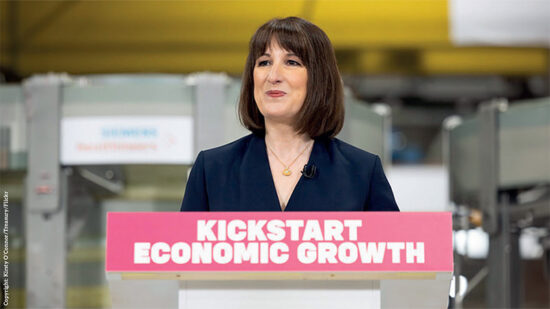Market performance since November has given a tantalising glimpse at a potential new environment in 2024. Investors were finally brave enough to shake off the security blanket of big tech and explore other parts of the market, from last year’s laggards, to emerging themes. However, the rally may prove fragile should any hint of inflation, or significant economic weakness emerge.
Until the last two months of 2023, the last year had been substantially dominated by the Magnificent Seven, those US mega-caps with exposure to the nascent AI trend. The rest of the US market was left behind – the S&P 500 equal-weight index returned 13.9% over the year, compared to 26.3% for the standard S&P 500 index. Other markets round the globe also struggled to match the returns from these technology giants.
If inflation revives, or any recession proves more severe than expected, all bets may be off, but in the absence of those scenarios, two questions may be front of mind for investors: whether these mega cap technology companies can keep motoring, and whether market leadership can continue to broaden out to the rest of the market.
See also: Tech funds top the rankings for 2023
Many fund managers agree that valuations for the mega-caps now look stretched. In his 2024 outlook, Mark Hawtin, manager on the GAM Star Disruptive Growth fund says: “On the broadest measure, the S&P 500 trades on 18x 2024 expected earnings; this is above the average levels of the last 30 years. However, the equal-weighted S&P trades at 14x 2024 earnings, at the lower end of the average 30-year range. The forward PE of the M7 names is 29x and this is the key factor in our base case: that growth equities will remain robust but that the winners will come from below the M7 names.” Hawtin believes AI will still be important, but investors will focus on its real-world applications: healthcare, storage, and Software as a Service (SaaS).
There are other reasons to be cautious on the mega caps. Research from Evelyn Partners shows equity market concentration in the US is now at its highest level since the 1970s, with the ‘Magnificent Seven’ now representing 28% of the entire S&P 500 index. Equally, says AJ Bell investment director Russ Mould, if rate cuts do not appear on schedule, the aggregate $11.8trn market cap for these companies could look vulnerable: “Their share price and profit wobbles of 2022 showed they are not entirely immune to the economic cycle, so an unexpected recession could be one challenge. Sustained inflation could be another if it keeps rates higher than expected.”
However, few investors see an imminent collapse for these companies. For the most part, they are delivering high earnings, have a strong pipeline of growth and are likely to be supported by wide AI adoption over the next 12 months. It is difficult to see a scenario where markets make progress, but big tech companies collapse. Phil Haworth, head of equities at Aegon Asset Management says: “Few had anticipated these stocks outperforming their cheaper, smaller, more cyclical counterparts in a year of rising long real yields and surprisingly robust GDP growth. We believe the ‘magnificent seven’ may continue to perform well, especially those like Nvidia and Microsoft which are driving the development of AI.”
Broad-based growth
Nevertheless, Haworth says we should ‘absolutely’ expect greater market breadth in 2024. Andrew Bell, chief executive officer at Witan, says: “We’re positioned for a broad-based global recovery, where performance will be shared more widely than just seven stocks in the US market. Central banks are pausing interest rates. The pause is a turning point, not a pause on the way up. They will stick with their 2% inflation target, but interest rates will be falling way before we get to 2%, as long as the direction on inflation is right.”
“We think 2024 is going to be a year of recovery within a wider range of sectors in the market, across a wider range of countries.”
Alex Tedder, head of global and thematic equities at Schroders, agrees: “Investors will need to diversify more, while thinking much more about valuation, and focusing in on the structural trends that have become manifest in the last couple of years.”
“The ‘super seven’ have driven a re-rating in the US market, but are now trading on a negative yield gap, suggesting the market thinks they are more creditworthy than US treasuries.” He does not hold a negative view on the S&P 500 nor does he believe the rest of the S&P is egregiously valued. However, he adds, the capitalisation of “super seven” is greater than entire capitalisation of China, Japan, UK and France combined: “While these anomalies can persist for quite long periods, they do close over time. We think the rest of the world may catch up.”
He highlights China and Japan, but also the UK. He says the picture across emerging markets is improving because underlying rates of inflation are starting to fall. The inflation problems that used to weaken major emerging market economies appear to have dissipated. Equally, he says, there are certain markets where investors have given up: “China is a good example of that. Geopolitical concerns have seen it falling completely out of favour with international investors.” He believes Japan is also looking compelling, with the currency particularly weak and the economy competitive.
If there are no nasty surprises on inflation, and economies stick to their current path of a soft landing, investors may feel confident enough to explore other parts of the market and the Magnificent Seven may no longer dominate market returns. However, it is also difficult to see a scenario where big tech moves in a different direction to the broader market. While valuations are high, these companies can still make progress in the year ahead.
This article was written for our sister title Portfolio Adviser








